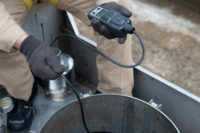Some jobs — like working in small spaces — are challenging, time-consuming and risk human life. Facilities need alternatives and remotely operated vehicles (ROVs) may be the right choice. Learn more about the many benefits of ROVs and how they’re specialized to perform any task in confined spaces.
What does ROV mean?
ROVs vary in type, dimension and purpose, but they all share a similar function. A user directs the device where they want it to go with a controller or computer. While scientific and academic communities use ROVs most often because they’re efficient at collecting data, more industries are beginning to recognize their potential.
Are there different types of ROVs?
There are several different types of ROVs, coming in many styles and sizes — each one is meant to fulfill various purposes. The working class is typically more complex because it performs a specialized task, while the observational type deploys to capture video or images. There are also miniature portable versions meant for work in smaller spaces.
How do ROVs work?
There are many types of ROVs because their roles determine what attachments they need. Each has a wide range of capabilities, even though their size and shape vary widely. Although people can equip them with various parts for different functions, most come with standardized equipment.
Here are a few parts that come standard on an ROV:
- Camera: Users view their surroundings through its high-definition cameras. It also lets them save videos or images to catalog whatever they find while using it.
- Lights: Most work in low-light conditions, so lights help users navigate properly.
- Manipulator: A manipulator goes by a few different names, but they all represent the small arm-like attachment many have. While it doesn’t have special functions, it can easily move objects for a clear path or better view.
- Thrusters: Many have thrusters to help them move. These come in handy underwater because they propel them forward.
While these basic attachments are necessary for remote navigation, an ROV can have any number of upgrades or additional parts. For example, the Scripps Institution of Oceanography used special sampling attachments to collect water at a depth of 3,000 feet. ROVs can serve any purpose with the right equipment.
The challenge of confined spaces
Confined spaces have narrow or limited entry and exit points, making it risky for humans to navigate them manually. These areas include silos, tunnels, ductwork, pipes or pits. Workplace regulations require managers and employers to ensure their employees have breathable air and enough room to move around, which can be challenging when the spaces are tight or have low visibility.
ROVs don’t need to breathe air or have workers monitor them for safety reasons, so they’re ideal for working in such environments. Facilities can use them for welding in tight spaces or fixing blockages in hazardous conditions. Many use them underwater for those exact purposes, though they’re also useful for land operations if they can crawl.
Different uses for ROVs in confined spaces
The applications of ROVs in confined spaces are mainly for inspection, intervention and repair. Their sizes differ significantly to make small spaces incredibly accessible, so they work effectively in most scenarios.
For example — since foundations are primarily damaged by water saturation — they could safely deploy for routine inspections to ensure a building’s integrity because they stay underwater for as long as it takes to fix the issue. Repairing and inspecting hydroelectric plants are some of the most common uses for ROVs in confined spaces.
Workers use them to inspect underwater structures for damage or blockages because it’s much safer than sending someone manually. Facilities can use ROVs to perform routine maintenance since they easily fit into small spaces — like pipes or maintenance holes — to benefit employees and reduce overhead costs.
Can ROVs replace confined space work?
ROVs can replace humans in confined space work because their equipment can handle the job safely and effectively. While many ROVs have a high initial cost, there is value in protecting employees. Additionally, their use in commercial or manufacturing settings can even save money.
An ROV has several benefits for any scenario:
- Cost-effective: The only labor comes from whoever controls the machine, so no company has to pay professionals to do a specialized job. It also reduces insurance costs when employees are no longer doing risky confined space work.
- Secure: It can do upkeep and preventative care for infrastructure to ensure structures stay in the best condition. For example, it can routinely deploy to watch and alert for damage in a foundation or ductwork.
- Safe: Much confined space work is dangerous, but it can replace humans so no one has to risk their safety.
- Efficient: It can quickly carry out a task because it has specialized tools. Miniature portable types streamline confined space work because they don’t need to meet a safety checklist before doing their job.
Confined space work comes with costs and risks when humans perform it, but an ROV ensures employees stay protected and their facility saves money.
ROVs outperform in confined space work
There are many different types of ROVs specializing in a variety of industries. Their attachments are customizable for inspection, detection or alteration, so they’re excellent choices for whatever confined space work a facility needs them to accomplish.



